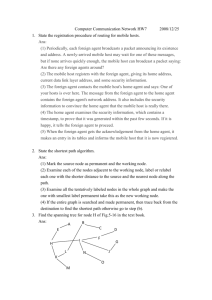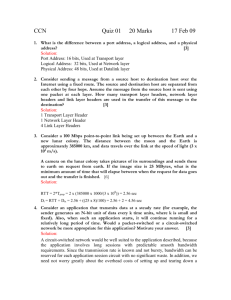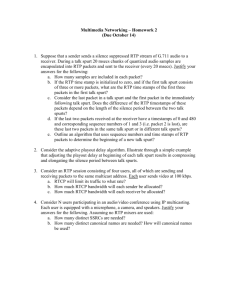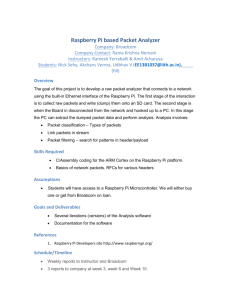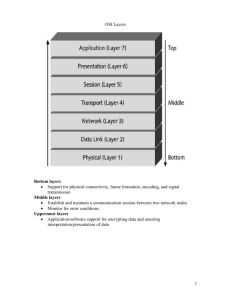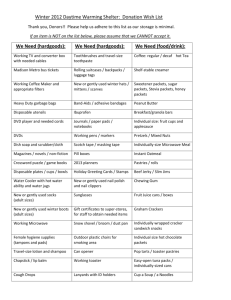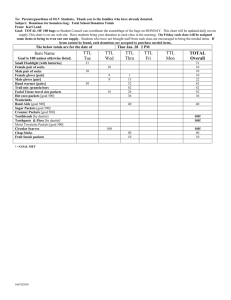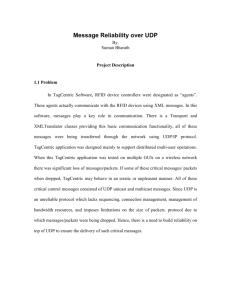Performance Control of high-capacity IP networks for
advertisement
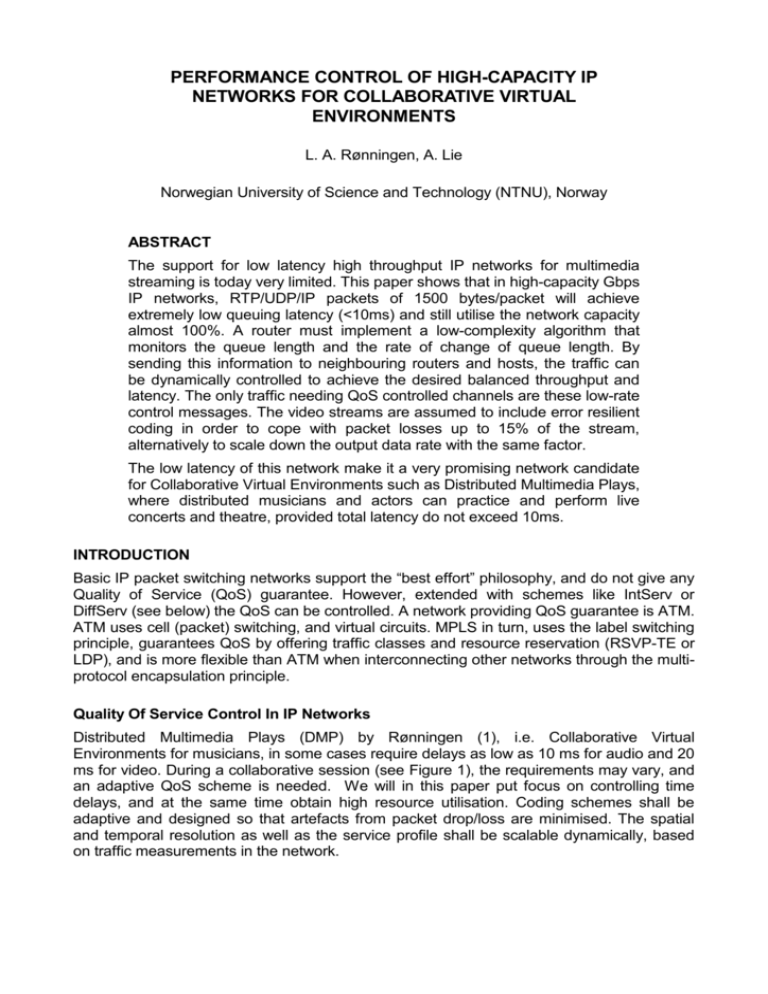
PERFORMANCE CONTROL OF HIGH-CAPACITY IP NETWORKS FOR COLLABORATIVE VIRTUAL ENVIRONMENTS L. A. Rønningen, A. Lie Norwegian University of Science and Technology (NTNU), Norway ABSTRACT The support for low latency high throughput IP networks for multimedia streaming is today very limited. This paper shows that in high-capacity Gbps IP networks, RTP/UDP/IP packets of 1500 bytes/packet will achieve extremely low queuing latency (<10ms) and still utilise the network capacity almost 100%. A router must implement a low-complexity algorithm that monitors the queue length and the rate of change of queue length. By sending this information to neighbouring routers and hosts, the traffic can be dynamically controlled to achieve the desired balanced throughput and latency. The only traffic needing QoS controlled channels are these low-rate control messages. The video streams are assumed to include error resilient coding in order to cope with packet losses up to 15% of the stream, alternatively to scale down the output data rate with the same factor. The low latency of this network make it a very promising network candidate for Collaborative Virtual Environments such as Distributed Multimedia Plays, where distributed musicians and actors can practice and perform live concerts and theatre, provided total latency do not exceed 10ms. INTRODUCTION Basic IP packet switching networks support the “best effort” philosophy, and do not give any Quality of Service (QoS) guarantee. However, extended with schemes like IntServ or DiffServ (see below) the QoS can be controlled. A network providing QoS guarantee is ATM. ATM uses cell (packet) switching, and virtual circuits. MPLS in turn, uses the label switching principle, guarantees QoS by offering traffic classes and resource reservation (RSVP-TE or LDP), and is more flexible than ATM when interconnecting other networks through the multiprotocol encapsulation principle. Quality Of Service Control In IP Networks Distributed Multimedia Plays (DMP) by Rønningen (1), i.e. Collaborative Virtual Environments for musicians, in some cases require delays as low as 10 ms for audio and 20 ms for video. During a collaborative session (see Figure 1), the requirements may vary, and an adaptive QoS scheme is needed. We will in this paper put focus on controlling time delays, and at the same time obtain high resource utilisation. Coding schemes shall be adaptive and designed so that artefacts from packet drop/loss are minimised. The spatial and temporal resolution as well as the service profile shall be scalable dynamically, based on traffic measurements in the network. Synchronisation layer Visual elementary stream Audio elementary stream RTP/UDP/IP packet RTP/UDP/IP packet RTP/UDP/IP RTP/UDP/IP RTP/UDP/IP RTP/UDP/IP Figure 1 One host site of Distributed Multimedia Plays showing visual and audio streams. Each elementary stream gets its unique RTP/UDP/IP packet stream. The collaboration between musicians requires a maximum latency of 10ms. IntServ, DiffServ, And Traffic Shaping IntServ (Braden et al (2) and Wroclawski (3)) guarantees the QoS level through per-flow resource reservation (RSVP) and admission control. The drawbacks of IntServ are that it is not very flexible, and that the overhead traffic becomes large in large networks. As an evolution from IntServ, IETF designed the DiffServ (Li et al (4)) that builds upon priority classes of traffic and decentralized control. Packets entering the network will be marked according to priority, and routers use this to put the packets into the right outgoing priority queues. Traffic shaping (Rønningen (5)) is a principle used to control traffic streams through controlling the mean value and variance of packet rates. Queuing, dropping and content downscaling are used as control mechanisms. How Much Traffic Control Is Needed? In IP networks, it can be shown that with short packets and high link capacity the utilisation can approach 100% and the absolute delays can be measured in microseconds (see below). This result was recognised by the designers of ATM, where the link capacity is 156 Mbps and the cell length is 53 bytes. The same rationale has been used for satellite TDM multiplexes, where the channel capacity can be 40 Mbps and the transport packets are 188 bytes plus error correction bytes. The outgoing link and packet queue of an IP router has been simulated. The simulation shows that with increasing link capacity, the utilization of the link can be close to 100% and the delay kept at an acceptable level, which is about 10 ms for Distributed Multimedia Plays (1). Further, 1Gbps IP networks will only need some sort of admission control and a packet drop mechanism based on the link utilisation when it approaches 100%. SYSTEM DESCRIPTION The system to be studied shall support adaptive multimedia applications like Distributed Multimedia Plays. To reduce the basic data rate generated from a scene, it is assumed that video and sound objects can be tracked and captured in real time. Each object is treated as an entity with its private RTP/UDP/IP traffic stream. There will always be a dependency between streams, but the aim is to reduce this to a minimum. Adaptive compression will be performed within each object, and not between objects. Scene description is according to MPEG-4 (BIFS). The synchronisation and multiplexing as defined in MPEG-4 are entirely handled by the RTP/UDP/IP combined header (Kikuchi et al (6)). Setup and release of services can when needed be handled by the RTSP protocol. A QoS management entity will implement the RTP/UDP/IP protocols, traffic control, transport and routing. Proposed Traffic Control And Encoding The following network characteristics have been chosen: Host link capacity Ch=30Mbps (~HDTV), router link capacity Cr=1Gbps, and IP packet length L=1500 bytes. Thus, one user can never saturate the core network alone. Three traffic classes are defined: TC1: uses reservation, either with IntServ or DiffServ with RSVP. About 10% of the total capacity could be assigned to TC1. The overhead traffic from IntServ would give a small load. TC2: With feedback “scale-message” (scale-msg), sent to neighbour sources (scale-msg sent in class TC1). The aim is to ask traffic sources to scale down their traffic, and to send “admission denied” to hosts. In addition, when queue lengths exceed certain number, packet will be dropped. In host, every other 2,4,8,16,… packets can be dropped. In the routers a large number of streams are merged, and it may not be necessary to check which packets to drop, just drop the arriving packet when the queue length exceeds a certain value. The following video coding scheme is introduced at the source host: vertical and horizontal “interlace” coding of objects, and interpolation in the receiver when lost packets. Se section MPEG-4 scenes, objects, and encoding of video and sound below. TC3: TCP based, for safe file transfer, delay not critical. In order to implement the TC2 traffic class, the following algorithm is proposed and must be performed periodic. The prediction of queue-lengths is performed using time series analysis, with exponential smoothing. At interval time points i (in simulations every 1ms), each router and host do the following: measure the queue length x i calculate weighted queue length m ci xi , (1) where ci are weights, decreasing exponentially backwards in time i . calculate the growth rate ci xi xi 1 (2) if the queue length has become too large ( x max ), drop packets from selected streams according to the rule described above. After n measurements (in simulations n =5), routers and hosts form the sum s ci xi ci xi xi1 (3) read incoming scale-msg calculate the metric for scale-msg, i.e. the relative number sw( j ) 1 exp[ s( j ) / k1 s( j 1) / k2 ] (4) where j is a router or host and k1 and k 2 are constants if sw(j) k3 (to prevent sending scale-msg when there is no need for it), send scale-msg( sw(j) ) to all neighbour sources of router j if an edge router: inform hosts if admission is denied for a the next period of length n when predicted queue length smax Protocols For setup and release of channels, the RTSP protocol is applied. For transport of multimedia content like DMP, the RTP/UDP/IP protocols together support the QoS control parameters needed. The QoS management entity in hosts and routers (hardware) must process the RTP/UDP/IP headers as one header (performance/implementation aspect). This header implements all synchronisation, timing and multiplexing similar to that specified by MPEG-4 (6). The following fields are included in the common header: RTP: Version, Payload type, Sequence number, Timestamp, and Synchronisation source (plus a few more). UDP: Source port, Destination port, Length, and Checksum. IPv6: Version, Class, Flow label, Payload length, Next header, Hop limit, Source IP address, and Destination IP address. The Sequence number and the Synchronisation source number are used to uniquely identify each object stream. MPEG-4 Scenes, Objects, And Encoding Of Video And Sound In a fully implemented MPEG-4 Distributed Multimedia Plays, the scenes must have live object texture segmentation (e.g. using blue-screen), each object e.g. being either a musician or a static scene object. The video capture may include 2D interlacing (both in horizontal and vertical directions, in contrast to ordinary even/odd lines), to enable easy interpolation of missing frames in the decoder. A minimum requirement is to add error resilient mechanisms as provided by the MPEG-4 standard to enable graceful degradation of visual and audio streams on packet loss. The benefits of using object segmented scene, rather than conventional rectangular video, is that each stream will be more robust to packet losses, and give a lower total data rate. Thus, each such object stream (called elementary stream in MPEG-4) will be transmitted as independent RTP/UDP/IP packets (i.e. not using the flex-mux tool of MPEG-4 DMIF layer), see Figure 1. In this way, each stream will be almost statistically independent, and the merging of these streams will give a negative exponential distribution of interarrival times. This simplifies calculations and simulation modelling. SIMULATION MODELS AND THE M/D/1 QUEUE The theoretical M/D/1 queuing model can be shown to be a good approximation for describing an output link and its queue of a router. This is true when the packet length and the link capacity are constants. The total input stream approaches “Markovian”, that is, the interarrival time distribution approaches the negative exponential distribution when a large number of small, independent streams merge. The simulated network consists of 32 source hosts and three routers each with least 16 I/O links, connected to other routers and a number of destination hosts. The 32 source hosts are modelled with two traffic generators. One generator feeds a host M/D/1 queue (named SourceHost1 in Figure 2), and the second feeds the edge router directly, aggregating the total traffic from 31 hosts and a number of routers (RouterGenerator1). Two other traffic generators feed the other two routers, aggregating the traffic from other routers. The three routers are modelled as a series of M/D/1 queues. In order to use IP packets of 1500 bytes lengths, and to obtain an end-to-end delay of less than 10 ms for a small percentage of the packets, the host links have a capacity of 30Mbps (HDTV, DV, 3D mpeg-4 object streams), and the links between routers in the network have a capacity of 1 Gbps. RouterGenerator2 RouterGenerator3 RouterGenerator1 DestinationHost1 SourceHost1 R2 R3 R1 Scale-msg Dest1 Dest2 Dest3 30Mbps 1Gbps Figure 2 – Traffic model showing the primary traffic and the traffic control messages (scale-msg), the latter showed with dashed lines. The SourceHost1 traffic generator generates packets with interarrival times drawn from a negative exponential distribution. The traffic generators for R1, R2, and R3 use the same type of generator. All packets from RouterGenerator1 are routed out into the cloud (Dest1) after arrival at R2. The same principle applies for RouterGenerator2 and 3. Packets from SourceHost1 are the only packets that pass through all five queues. Scale-msg is sent from router Rj, j 1,2,3, backwards to routers and hosts that give direct input to router j . It is assumed that an advanced routing algorithm distributes the traffic adaptively on several “best” routes. Since scale-msgs have the highest priority (TC1 traffic class) and are sent periodic, this transfer delay is neglected, and in the simulations global variables are just set to regulate input traffic. An entity Scaler( j ) is activated each 1 ms (or other) to perform the measurements and prediction calculations (eq. (1) and (2) presented in section Proposed traffic control and encoding). Each 5 ms a scale-msg( sw(j) ) is sent back to sources as indicated in Figure 2. The traffic generators simulate scaling of both profile and level by just terminating packets before they enter any queue, according to the parameters of the scalemsgs. Simulation of A Single M/D/1 Queue With a traditional non-adaptive video/audio encoder it was assumed that about 0.2% of the multimedia content could be dropped at the receiver without giving noticeable artefacts. This means that 0.2% of the packets can have delays higher than 10 ms. The interarrival time of packets to the queue was drawn from a negative exponential distribution (to give the Markovian characteristics). The mean interarrival time was adjusted to give the figures as shown in Table 1. Table 1 Simulated delay and utilisation vs link capacity for a single M/D/1 queue. Packet length = 1500 bytes Link capacity Cr 10 Mbps 30 Mbps 1 Gbps 1 Gbps 30 Gbps 64.8 % 87.0% 98.98 % 99.98 % 99.986 Mean delay 2.31 ms 1.76 ms 0.52 ms 5.52ms 0.462 ms Delay > 10ms 0.223 % 0.236 % 0.00 % 1.86 % 0.00 % Link utilisation When Cr= 1 Mbps, all packets are delayed at least 12 ms (transmission latency alone), and this is not usable for DMP audio. With Cr =10 Mbps, about 0.2% of all packets have delays larger than 10 ms at a link utilisation of 65%. With Cr =30 Mbps, about 0.2% of all packets have delays larger than 10 ms at a link utilisation of 87%. With Cr =1 Gbps, about 0.2% of packets have delays larger than 10 ms, but then the link utilisation is 99.98%! With C=30 Gbps, the maximum delay was 800 microseconds at a link utilisation of 99.986%. The simulation shows that with increasing link capacity, the utilization of the link can be close to 100% and the delay kept at an acceptable level. Simulation Of The Network In Figure 2 With Traffic Controls The traffic controls as proposed in section Proposed traffic control and encoding were implemented in hosts and routers. The SourceHost1 queue rejects new packet arrivals when there are eight packets in queue. The corresponding figure for routers is 200. (This figures were selected after some experimentation). The interarrival times of packets into host and routers were set to overload the network, that is 200 microseconds for the host and 8 microseconds for the routers. It is assumed that the sources are scalable, i.e. that the visual and/or audio bit rates can be adjusted by altering compression efficiency and/or sampling rate. However, the traffic controls simulated behaved nicely, and even if the link utilization for routers became 100% and for hosts 92%, all packets showed a delay of less than 10 ms (see Figure 3). The traffic stream into R3 consists of 32 sub-streams merged together randomly. E.g., from stream number 20, only 4 out of 417000/32 (the number of packets simulated), that is 0.3% of the packets, were dropped on arrival. For SourceHost1, the total number of packets were 19804, and 2470 were dropped in host queue 1, which is 12.5%. 3.75% of the packet transferred from the source host to the destination host used more than 8 ms. All packets in the simulation used less than 10 ms. pdf, tot delay > 8ms 0,2500 probability 0,2000 0,1500 0,1000 0,0500 70 00 72 00 74 00 76 00 78 00 80 00 82 00 84 00 86 00 88 00 90 00 92 00 94 00 96 00 98 00 0,0000 microseconds Figure 3 Simulated probability density function of the packet delay above 8ms of the total system 90 00 80 00 70 00 60 00 50 00 40 00 30 00 20 00 10 00 0,16 0,14 0,12 0,1 0,08 0,06 0,04 0,02 0 0 probalility pdf, tot delay microseconds Figure 4 Simulated probability density function of the packet delay of total system, from input to SourceHost1 to output of DestinationHost1 CONCLUSIONS The proposed traffic control and network architecture have been modelled and simulated, and performs as expected. The most important results are: With the controls and capacities as specified, the link channel utilisation between routers can approach 100%, and the time delay can be guaranteed In the source host, 12.5 % of the packets had to be dropped due to exceeded maximum queue length. In this case it is absolutely necessary to code in a way that guarantees graceful degradation. Adaptive coding, 2D interlace, error resilience, or other schemes should be investigated. If 2D interlacing is being used, packets are dropped every other, every fourths, every eighths, and so on, to support interpolation in the receiver. Regarding routers and dropping of packets, it might be satisfactory just to drop packets when the queue lengths become too large. However, we assume that intelligent sorting and dropping might be necessary, and then routers have to check the whole RTP/UDP/IP header. Links between routers: if a high-capacity channel (fiber) is available, do not divide the capacity into smaller channels (as SDH, Sonet), but apply the whole capacity for one common packet stream. REFERENCES 1. L. A. Rønningen, February 1999. The Combined Digital Satellite Broadcast and Internet System. Telenor Satellite Services. 2. R. Braden, D. Clark, S. Shenker, June 1994. Integrated Services in the Internet Architecture: an Overview. IETF RFC1633. 3. J. Wroclawski, September 1997. The Use of RSVP with IETF Integrated Services. IETF RFC2210. 4. T. Li, Y. Rekhter, October 1998. A Provider Architecture for Differentiated Services and Traffic Engineering (PASTE). IETF RFC2430. 5. L. A. Rønningen, 1983. Analysis of a Traffic Shaping Scheme. The 10th International Teletraffic Congress, Montreal 1983 (part of the authors Ph.D. thesis from 1981). 6. Y. Kikuchi, T. Nomura, S. Fukunaga, Y. Matsui, H. Kimata, November 2000. RTP Payload Format for MPEG-4 Audio/Visual Streams. Status: PROPOSED STANDARD. IETF RFC3016.
